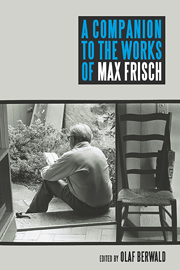Book contents
- Frontmatter
- Contents
- Acknowledgments
- Note on the Abbreviations
- Introduction: Max Frisch in the Twenty-First Century
- 1 Max Frisch's Early Plays
- 2 Spielraum in Max Frisch's Graf Öderland and Don Juan: Transparency as Mode of Performance
- 3 Max Frisch's Biedermann und die Brandstifter and Die große Wut des Philipp Hotz
- 4 Max Frisch's Andorra: Balancing Act between Pattern and Particular
- 5 Eternal Recurrence in Life and Death in Max Frisch's Late Plays
- 6 Max Frisch's Early Fiction
- 7 From Life to Literature: Max Frisch's Tagebücher
- 8 “Writing in order to be a stranger to oneself”: Max Frisch's Stiller
- 9 Cybernetic Flow, Analogy, and Probability in Max Frisch's Homo Faber
- 10 The Ends of Blindness in Max Frisch's Mein Name sei Gantenbein
- 11 Max Frisch's Montauk. Eine Erzählung
- 12 Man, Culture, and Nature in Max Frisch's Der Mensch erscheint im Holozän
- 13 “My life as a man. Everyman”: Max Frisch's Blaubart. Erzählung
- 14 Max Frisch's Essays and Speeches
- Frisch's Major Works
- Select Bibliography
- Notes on the Contributors
- Index
3 - Max Frisch's Biedermann und die Brandstifter and Die große Wut des Philipp Hotz
Published online by Cambridge University Press: 05 December 2013
- Frontmatter
- Contents
- Acknowledgments
- Note on the Abbreviations
- Introduction: Max Frisch in the Twenty-First Century
- 1 Max Frisch's Early Plays
- 2 Spielraum in Max Frisch's Graf Öderland and Don Juan: Transparency as Mode of Performance
- 3 Max Frisch's Biedermann und die Brandstifter and Die große Wut des Philipp Hotz
- 4 Max Frisch's Andorra: Balancing Act between Pattern and Particular
- 5 Eternal Recurrence in Life and Death in Max Frisch's Late Plays
- 6 Max Frisch's Early Fiction
- 7 From Life to Literature: Max Frisch's Tagebücher
- 8 “Writing in order to be a stranger to oneself”: Max Frisch's Stiller
- 9 Cybernetic Flow, Analogy, and Probability in Max Frisch's Homo Faber
- 10 The Ends of Blindness in Max Frisch's Mein Name sei Gantenbein
- 11 Max Frisch's Montauk. Eine Erzählung
- 12 Man, Culture, and Nature in Max Frisch's Der Mensch erscheint im Holozän
- 13 “My life as a man. Everyman”: Max Frisch's Blaubart. Erzählung
- 14 Max Frisch's Essays and Speeches
- Frisch's Major Works
- Select Bibliography
- Notes on the Contributors
- Index
Summary
Biedermann und die brandstifter (1958; translated under various titles: The Fire Raisers, The Firebugs, and The Arsonists) has attained international renown and is considered Max Frisch's most famous play. Yet many are aware neither of its complex evolution through various literary genres, nor of its relationship with Die große Wut des Philipp Hotz (The Great Rage of Philipp Hotz, 1958), its sister drama originally written to accompany Biedermann, but now only rarely performed. This chapter seeks to provide an overview of the literary life of both plays by introducing their primary themes, possible scholarly interpretations, and, when possible, the authorial intent behind their inception.
Biedermann und die Brandstifter
The Inception and Evolution of Biedermann
The versatile writer Max Frisch proved successful as an author of prose as well as drama and clearly enjoyed manipulating genre boundaries in his works. Biedermann und die Brandstifter provides us with such an example. Over the course of its development, the story took form in four different genres: short prose sketch, radio play, stage play, and television film.
Frisch penned the first incarnation of the Biedermann story, entitled “Burleske,” in a 1948 Tagebuch entry. This six-page fable sketches out the work that would eventually become known as Biedermann und die Brandstifter. In it Frisch offers only a very general outline of the action, introduces no specific characters, and addresses the reader directly as the protagonist using the second-person familiar form “du.”
- Type
- Chapter
- Information
- A Companion to the Works of Max Frisch , pp. 39 - 57Publisher: Boydell & BrewerPrint publication year: 2013



